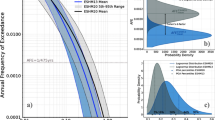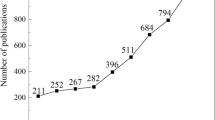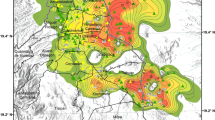Abstract
The main features of the Risk-UE project approach to assessing the ground-shaking (and related hazards) distribution within urban areas are described, as a basis for developing seismic damage scenarios for European cities. Emphasis was placed in the project on adoption of homogeneous criteria in the quantitative treatment of seismicity and in constructing the ground-shaking scenarios, despite wide differences in amount and quality of data available for the cities involved. The initial steps of the approach include treatment of the regional seismotectonic setting and the geotechnical zonation of the urban area, while the hazard assessment itself takes the form of both a deterministic analysis, and of a probabilistic, constant-hazard spectra analysis. Systematic 1D site response analyses were used, mostly in the softer soil zones, to modify (when needed) the obtained ground motion maps. Earthquake induced hazard effects, such as liquefaction and landsliding, are also briefly dealt with at the end.
Similar content being viewed by others
References
Ambraseys N, Simpson K, Bommer J (1996) Prediction of horizontal response spectra in Europe. Earthquake Eng Struct Dyn 25:371–400
Azzaro R, Barbano MS (1999) Seismogenic features of SE Sicily and scenario earthquake for Catania. In: Faccioli E, Pessina V (eds) The Catania project: earthquake damage scenarios for a high risk area in the Mediterranean. CNR-GNDT, Rome, pp 9–13
Bardet JP, Ichii K, Lin CH (2000) EERA: a computer program for equivalent-linear earthquake site response analyses of layered soil deposits. University of Southern California. http://www.geoinfo.usc.edu/gees
Bommer J, Elnashai A, Weir A (2000) Compatible acceleration and displacement spectra for seismic design code. In: 12th World Conference on Earthquake Engineering. Auckland, New Zeland, Paper 744 no. 207
Bommer J (2002) Deterministic vs. probabilistic seismic hazard assessment: an exaggerated and obstructive dichotomy. J Earthquake Eng 6 (Special Issue 1):43–73
Boschi E, Guidoboni E (2001) Catania terremoti e lave dal mondo antico alla fine del Novecento. Istituto Nazionale di Geofisica e Vulcanologia – SGA Storia Geofisica e Ambiente, Bologna, Italy
Cabañas L, Benito B, Cabañas C, López M, Gómez P, Jiménez ME, Alvarez S (1999) Caracterización del movimiento del suelo en ingeniería sísmica. Fisica de la Tierra vol 11 (Ingeniería Sísmica), ed Complutense
CEN (Comité Européen de Normalisation) (2004) Eurocode 8: design of structures for earthquake resistance – Part 1: general rules, seismic actions and rules for buildings. Brussels, May
Cornell A (1968) Engineering seismic risk analysis. Bull Seism Soc Am 58:1583–1606
Esteva L (1970) Seismic risk and seismic design decisions. In: Hansen RJ (ed) Seismic design of nuclear power plants. MIT Press, Cambridge, Massachusetts, USA
Faccioli E, Vanini M, Frassine L (2002) “Complex” site effects in earthquake ground motion, including topography. In: 12th European Conference on Earthquake Engineering. Paper 844
García Mayordomo J, Faccioli E, Paolucci R (2004) Comparative study of the seismic hazard assessments in European national seismic codes. Bull Earthquake Eng 2:51–73
Glavcheva R, Simeonova S, Hristova Tz, Solakov D (1983) Generalized isoseismals of the high intensities for earthquakes in Bulgaria. Bulgarian Geophys J 9(3):69–77
Grandori G, Drei A, Perotti F, Tagliani A (1991) Macroseismic intensity versus epicentral distance: the case of central Italy. Tectonophysics 193:165–171
Joyner W, Fumal T (1984) Use of measured shear-wave velocity for predicting geologic site effects on strong ground motion. In: Proc. Eighth World Conference on Earthquake Engineering, vol. 2. San Francisco, pp 777–783
Lungu D, Cornea C, Demetriu S, Aldea A (1999) Microzonage sismique de la ville de Bucarest. Cinquième Colloque National, Génie Parasismique et Réponse Dynamique des Ouvrages, Association Française du Génie Parasismique AFPS, Cachan, 19–21 October, pp 99–111
McGuire R (1995) Probabilistic seismic hazard analysis and design earthquakes: closing the loop. Bull Seism Soc Am 85:1275–1284
Meletti C, Patacca E, Scandone P (2000) Construction of a seismotectonic model: the case of Italy. PAGEOPH 157(1–2):11–35
Nagakawa K, Shiono K, Inoue N, Sano M (1996) Geological characteristics and problems in and around Osaka basin as a basis for assessment of seismic hazard. In: Special issue of Soils and Foundations. Japanese Geotechnical Society, Tokyo, pp 15–28
Nakamura Y (1989) A method for dynamic characteristic estimation of subsurface using microtremor on the ground surface. Rep Railway Tech Res Inst Jpn 30(1):25–33
Ordaz M, Jara JM, Singh SK (1991) Riesgo sísmico y espectros de diseño en el estado de Guerrero. Technical Report, Instituto de Ingenieria, UNAM, Mexico City
Sabetta F, Pugliese A (1996) Estimation of response spectra and simulation of nonstationary earthquake ground motions. Bull Seism Soc Am 86:337–352
Tromans I, Bommer J (2002) The attenuation of strong-motion peaks in Europe. In: Proceedings 12th European Conference on Earthquake Engineering, London. CD Rom, Paper no. 394
Wells D, Coppersmith K (1994) New empirical relationships among magnitude, rupture length, rupture width, rupture area and surface displacement. Bull Seism Soc Am 84(4):974–1002
Author information
Authors and Affiliations
Corresponding author
Rights and permissions
About this article
Cite this article
Faccioli, E. Seismic hazard assessment for derivation of earthquake scenarios in Risk-UE. Bull Earthquake Eng 4, 341–364 (2006). https://doi.org/10.1007/s10518-006-9021-2
Received:
Accepted:
Published:
Issue Date:
DOI: https://doi.org/10.1007/s10518-006-9021-2




